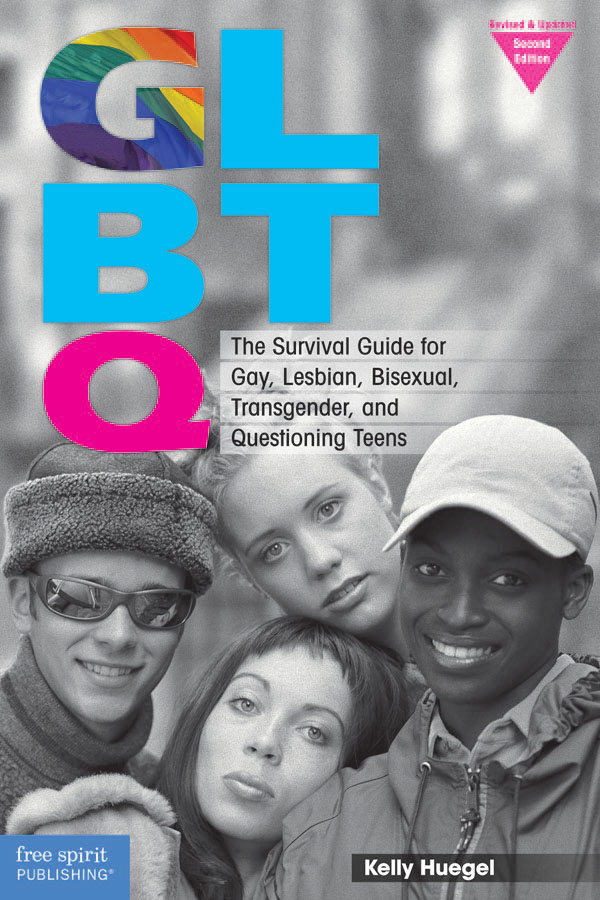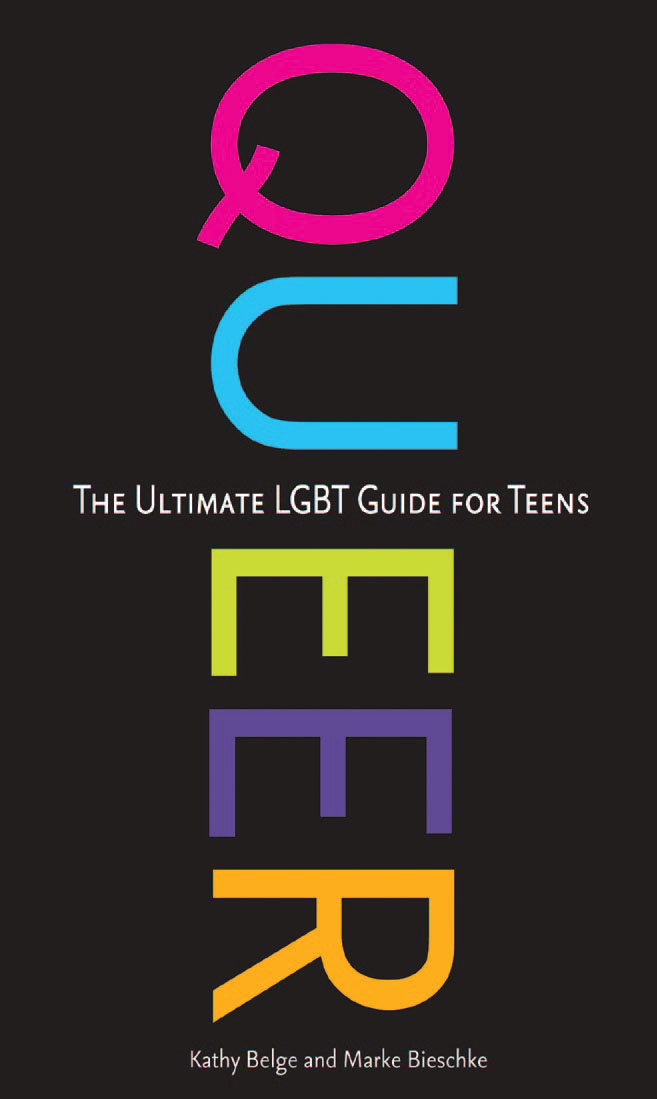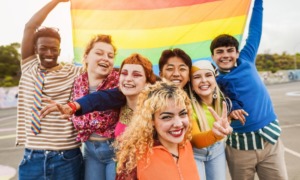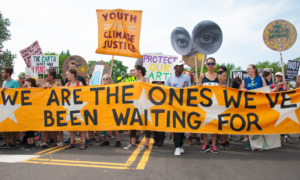GLBTQ: The Survival Guide for Gay, Lesbian, Bisexual, Transgender, and Questioning Teens:
 Revised and updated 2nd edition
Revised and updated 2nd edition
Kelly Huegel
Free Spirit Publishing
230 pages.
Kelly Huegel’s revision of her 2003 edition of GLBTQ reflects remarkable changes in the landscape for youth working out their place in that spectrum. The 2010 U.S. census counted same-sex couples for the first time. New legislation affecting civil rights, marriage rights and military policies has accompanied changes in society’s attitudes toward the 10 percent of the population who identify as not heterosexual. Although homophobia remains an ugly reality that leads to severe bullying and suicide, today many straight teens accept their “queer” peers, who reclaim a once negative label.
Huegel’s introduction describes her own journey toward her lesbian identity, including her suicide attempt in college, her fulfilling life with her partner a decade later, and employment with PFLAG (Parents, Families and Friends of Lesbians and Gays), helping others after accepting herself.
She begins with “GLBTQ 101,” defining the words represented by each letter: gay, lesbian, bisexual, transgender, and questioning. Then she debunks 15 “ridiculous” stereotypes such as “Queer people recruit.” The myth behind that fear—that GLBTQ people choose their sexuality and therefore can talk others into it—has resulted in this book’s banning in “a few” U.S. libraries, according to Huegel.
She cites the surveys and work of advocacy organizations such as the Gay, Lesbian, & Straight Education Network (GLSEN), along with other campaigns and legislation. Sidebars offer online references and suggested films, books and other resources, including pithy quotes from youth that illustrate many points.
A chapter about homophobia reveals sobering statistics from GLSEN’s 2009 National School Climate Survey of 7,261 GLBTQ students aged 13 to 21:
• 60 percent feel unsafe at school because of their sexual orientation, and more than one-third feel unsafe because of their gender identity or expression.
• 40 percent reported being physically harassed, and nearly 19 percent reported being physically assaulted in school.
In 2010, this bullying epidemic became headline news after several student suicides. Now “safe schools” movements show success with anti-bullying policies and trainings in tolerance. Gay-straight alliance clubs (GSAs) in schools are helping to change the climate. A new GLBTQ Online High School offers a secure online education and tools to help traditional public schools create “a more supportive and safer learning environment for GLBTQ students.” The chapter ends with strategies for responding when homophobia strikes. When a girl called Anna a dyke, for example, Anna, 17, smiled and responded, “You say that like it’s a bad thing.” The girl walked away.
A “Coming Out” chapter is full of crucial advice, from checklists to ascertain if you’re ready, to a list of possible responses to parents’ reactions. Chapters on school life and friends recommend that students find and rely on their supportive, “utterly diverse” GLBTQ community.
A “Dating and Relationships” chapter emphasizes that having sex isn’t necessary “to figure out your sexuality, sexual orientation, or gender identity.” It tackles dating violence with “An Abusive Relationship Self-Test.” A “Sex and Sexuality” chapter debunks “myths and misinformation.” The revelation that only four percent of students report that GLBTQ information is included in health classes makes Huegel’s details on the varieties of sexual activity, safe sex, and when to say no extremely valuable.
In a crucial chapter about religion and culture, Huegel explores why some religions—especially those that believe sexual relations are only for reproduction – don’t accept GLBTQ people. She lists “GLBTQ-Positive Religious Organizations” that advocate for acceptance in traditional churches, along with denominations known for welcoming GLBTQ people.
Transgender teens have their own chapter; understanding of their experiences has grown dramatically. “Gender identity is your internal sense of being male or female,” Huegel explains, while “gender expression is how you express your gender identity” in your appearance, which people assume matches your anatomical sex – but sometimes doesn’t. Questions and answers reveal what it means to be transgender – including a variety of groups from transsexuals to crossdressers, drag queens and intersex people – and help young people figure out whether they are transgender and what steps are involved in gender transitioning. Trans people have always been with us – some Native American cultures revere “Two-Spirit” people as healers and peacemakers.
A final chapter explores how to find colleges and careers with welcoming environments. A glossary; resource lists of books, films, websites, hotlines, and organizations; and an index increases the value of this essential resource for both queer and straight youth – and those who care about them. Savvy and wise, Huegel brings personal and professional experience to her insightful counsel.
Contact: (800) 735-7323, www.freespirit.com.
Queer: The Ultimate LGBT Guide for Teens
 Kathy Belge and Marke Bieschke
Kathy Belge and Marke Bieschke
Zest Books
208 pages.
Introducing themselves as “your tour guides to Planet Queer,” the authors of the hip, witty Queer handbook adopt the supportive tone of older siblings. Their “LGBT” subtitle shows an alternate format from Huegel’s “GLBTQ.”
“If you find yourself wondering if any of the terms describe you, you might be queer,” they explain. “Of course you might also just be questioning.” They embrace “queer” as an umbrella term for everyone in the spectrum, reclaiming a word often hurled as a slur.
Co-authors Kathy Belge, former director of an Oregon program for LGBT teens who writes about lesbian life for About.com and Curve magazine, and Marke Bieschke, a senior editor at the San Francisco Bay Guardian who speaks on gay issues for National Public Radio and CBS radio, reveal their own journeys in sidebars throughout the book. For example, “In Kathy’s Words” describes coming out at 19: Traveling across country on foot, she wrote her parents a letter. Her father’s reply was reassuring. Her mother described the Kathy she knew as “dead.” Kathy recalls “bawling my eyes out” before finding the courage to call home.
Today Kathy’s parents are proud of her for helping others come out; she recommends practicing ahead of time and counsels how to cope with reactions and find support if parents reject or “try to un-queer you.”
Discussing “Your Queer Sphere,” Belge and Bieschke describe their relief in joining the diverse queer community. They explain how to safely find others in chat rooms, Gay-Straight Alliances (GSAs), and by “gaydar.” They recommend the American Civil Liberties Union (ACLU), which champions LGBT teens’ rights, noting that students in private schools don’t have the same rights as those in public schools protected by the U.S. Constitution.
A chapter on overcoming “queerphobia” gives crucial advice on dealing with physical or sexual assault, bullying, and social traps. A list of “queer-safe rules” includes having rescue plans whenever you go out in public. “It takes a lot of strength to be brave and live your life and even more not to become a hater yourself,” the authors conclude. “In Marke’s Words” conveys his agony as a high school freshman whose track coach asked him to run in front of the rest of the team, then laughed and said, “You run like a faggot!”
A chapter on dating advice includes a quiz to assess whether a relationship is healthy and a checklist on abusive relationships. The final chapter demystifies queer sex in all its varieties and provides a table of sexually transmitted infections with symptoms, tests and treatment – important for any young person’s book about sexuality and sexual behavior. This chapter suggests protections for safer sex and explores the relationship between sex and love. A page on pornography tells the dirty truth: “Most ‘lesbian’ porn is made by straight men for straight men and has very little to do with the way real lesbians have sex.” A sex and technology section warns about protecting yourself from online “weirdos” and refraining from lying, gossiping, bragging, cruising for porn, posting naked photos, and sexting.
Being LGBT today, Belge and Bieschke note, is “totally different” from their youth a half generation ago with few role models and many anti-gay laws. Now many people live openly in “loving queer relationships” and “advocate for full equality.” It’s “a really exciting time to be queer because change is happening so rapidly,” they conclude. A resource section lists organizations, websites and books.
Contacts: (800) 225-3362, www.zestbooks.net.
Although GLBTQ and Queer inevitably overlap, their differences make both valuable and stronger together. GLBTQ is comprehensive and political, aiming for an audience from high school through college. Queer’s irreverent humor, attitude, and current slang will draw in teen readers.
Both cover identity, coming out, homophobia, friends, sexuality, and dating and relationships. Longer than Queer, GLBTQ examines school life, religion and culture, and transgender teens in depth, all only briefly mentioned in Queer, which doesn’t address any of the work and college issues that readers can find in GLBTQ. Both books are direct and frank, sharing authentic information from the queer community and committed advocates for youth. GLBTQ’s glossary, resource lists and index stimulate further research. Queer’s more modest resources satisfy curiosity; an additional strength is five teen advisors who helped develop the book.
Both books have their place in any youth-serving agency today.
Cathi Dunn MacRae, former editor of Voice of Youth Advocates (VOYA), specializes in teen writing and reading.































